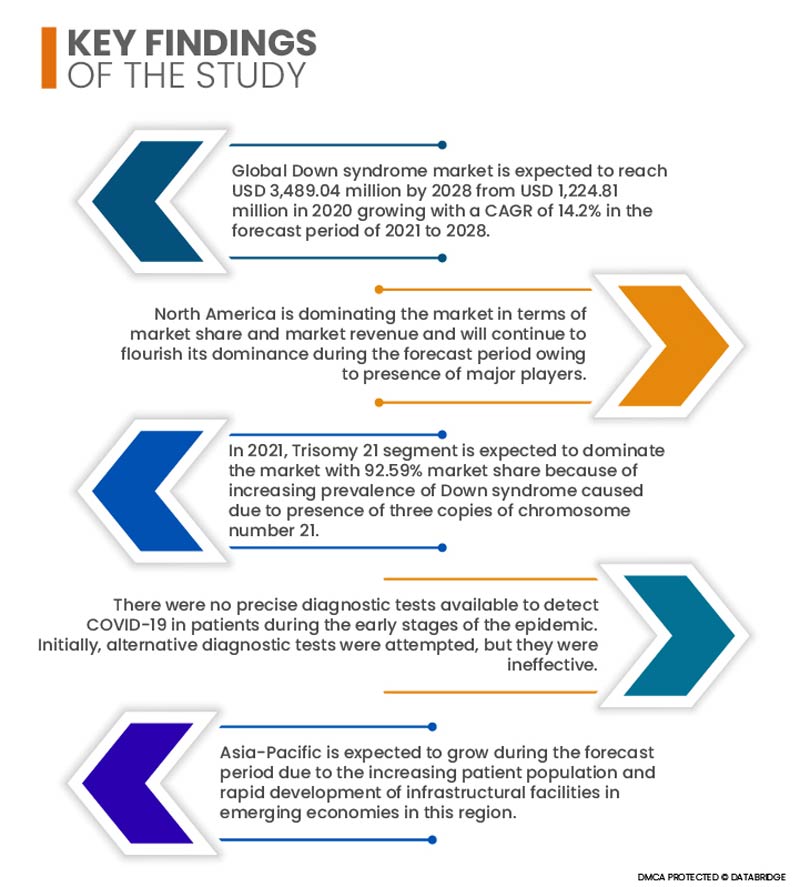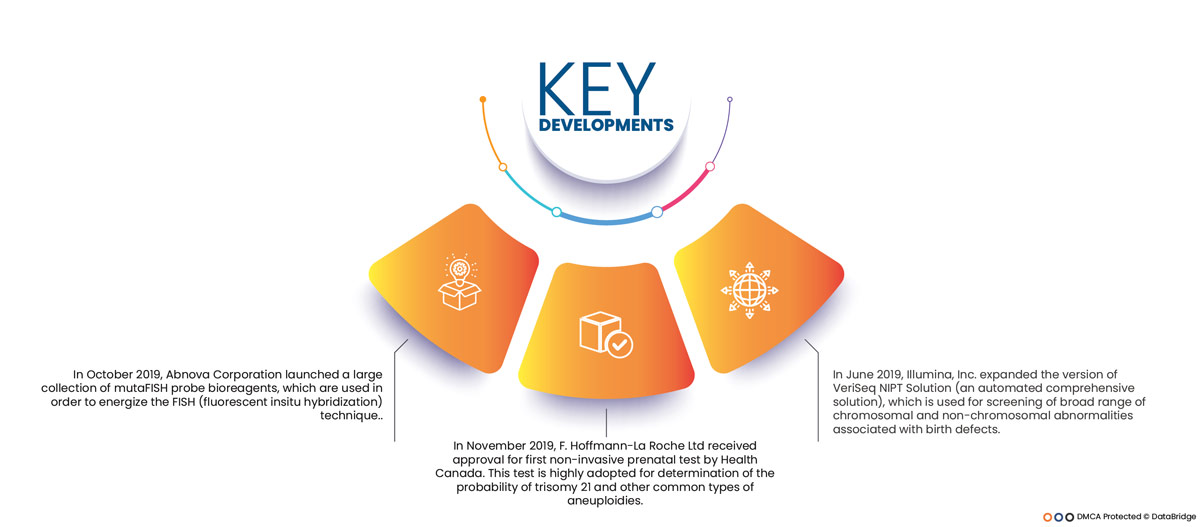다운증후군은 전 세계 사람들에게 영향을 미치는 매우 흔한 염색체 질환입니다. 또한, 다운증후군 환자는 선천성 심장 기형, 호흡기 및 청력 문제, 알츠하이머병, 소아 백혈병, 갑상선 질환을 겪을 가능성이 더 높습니다. 최근 의학 및 연구 기술의 발전으로 이러한 질환 중 여러 가지가 치료되었고, 많은 다운증후군 환자들이 건강한 삶을 누릴 수 있게 되었습니다. 그 결과, 최근 수십 년 동안 사람들의 기대 수명은 1983년 25세에서 현재 60세로 증가했습니다.
전체 보고서는 https://www.databridgemarketresearch.com/reports/global-down-syndrome-market 에서 확인하세요.
세계 다운증후군 시장은 2020년 12억 2,481만 달러에서 2028년 34억 8,904만 달러로 성장할 것으로 예상되며, 2021년부터 2028년까지 연평균 성장률(CAGR) 14.2%를 기록할 것으로 예상됩니다. 진단 및 치료 목적의 첨단 의료 기술 수요 증가와 급성 및 만성 질환 발병률 증가는 시장 성장을 촉진하는 주요 요인입니다. 고령 인구 증가, 개발도상국의 치료 옵션 접근성에 대한 인식 제고, 그리고 개인 가처분소득 증가 또한 시장 성장에 중요한 요인입니다.

전 세계적으로 노령 인구 기반의 증가로 인해 시장 성장률이 높아질 것으로 예상됩니다.
노년층은 만성 질환 및 장애 발생에 가장 취약합니다. 따라서 전 세계적으로 증가하는 노년층은 심장 질환, 호흡기 질환 및 기타 만성 질환 발생에 매우 취약합니다. 이는 결국 시장 성장의 중요한 결정 요인으로 작용할 것입니다. 공공 및 민간 부문의 의료 인프라 개발 지출 증가 또한 시장 성장을 촉진할 것입니다. 첨단 의료 기술 도입과 관련된 지속적인 연구 개발은 시장 성장의 폭을 다시 한번 확대할 것입니다.
보고서 범위 및 시장 세분화
보고서 메트릭
|
세부
|
예측 기간
|
2021년부터 2028년까지
|
기준 연도
|
2020
|
역사적인 해
|
2019 (2013~2018년으로 맞춤 설정 가능)
|
양적 단위
|
매출(백만 달러), 볼륨(단위), 가격(달러)
|
다루는 세그먼트
|
질병 유형(21번 삼염색체증, 다운 증후군 전좌, 모자이크 다운 증후군), 치료(진단, 요법), 최종 사용자(병원, 진료소, 재택 치료 시설, 치료 센터, 기타), 유통 채널(직접 입찰, 소매 판매, 기타)
|
포함 국가
|
미국, 북미의 캐나다 및 멕시코, 독일, 프랑스, 영국, 네덜란드, 스위스, 벨기에, 러시아, 이탈리아, 스페인, 터키, 유럽의 기타 유럽 국가, 중국, 일본, 인도, 한국, 싱가포르, 말레이시아, 호주, 태국, 인도네시아, 필리핀, 아시아 태평양(APAC)의 기타 아시아 태평양(APAC), 사우디아라비아, UAE, 남아프리카 공화국, 이집트, 이스라엘, 중동 및 아프리카(MEA)의 일부인 기타 중동 및 아프리카(MEA), 남미의 일부인 기타 남미 국가.
|
시장 참여자 포함
|
Natera, Inc.(미국), Next Biosciences(남아프리카공화국), AtilaBiosystems(미국), Myriad Genetics, Inc.(미국), PerkinElmer Inc.(미국), F. Hoffmann-La Roche Ltd(스위스), Demeditec Diagnostics GmbH(독일), Thermo Fisher Scientific Inc.(미국), Abnova Corporation(대만), Novus Biologicals(미국), Mayo Clinic Health System(미국), Boys Town National Research Hospital(미국), Boston Children's Hospital(미국), Kid Sense Child Development Corporation Pty Ltd(호주), Down Syndrome Cork(아일랜드), Children's Hospital Colorado(미국), ASDclinic.co.uk(영국), Abbott(미국), Physio.co.uk(영국), Illumina, Inc.(미국) 등이 있습니다.
|
보고서에서 다루는 데이터 포인트
|
Data Bridge Market Research 팀이 큐레이팅한 시장 보고서에는 시장 가치, 성장률, 시장 부문, 지리적 범위, 시장 참여자, 시장 시나리오와 같은 시장 통찰력 외에도 심층적인 전문가 분석, 환자 역학, 파이프라인 분석, 가격 분석, 규제 프레임워크가 포함되어 있습니다.
|
세그먼트 분석:
다운증후군 시장은 질병 유형, 치료, 최종 사용자 및 유통 채널을 기준으로 4가지 주요 부문으로 분류됩니다.
- 다운증후군 시장은 질병 유형에 따라 21번 삼염색체증, 전좌형 다운증후군, 모자이크형 다운증후군으로 구분됩니다. 21번 염색체가 세 개 존재하여 발생하는 다운증후군 유병률이 증가하고 있기 때문에, 2021년에는 21번 삼염색체증이 92.59%의 시장 점유율을 차지하며 시장을 장악할 것으로 예상됩니다. 또한, 발표된 보고서에 따르면 21번 삼염색체증은 다운증후군 환자의 98%를 차지합니다.
- 다운증후군 시장은 치료 기준으로 진단과 치료로 구분됩니다. 2021년에는 진단 부문이 87.46%의 시장 점유율을 기록하며 시장을 장악할 것으로 예상됩니다. 임산부는 태아의 성장에 영향을 미칠 수 있는 염색체 이상을 확인하기 위해 비침습적 산전 검사를 받는 것이 권장되기 때문입니다. 이러한 만성 융모 채취는 태아의 건강 상태를 확인하는 것 외에도 다양한 진단 방법을 통해 시행됩니다.
- 다운증후군 시장은 최종 사용자 기준으로 병원, 진료소, 재택 치료 시설, 치료 센터 등으로 세분화됩니다. 2021년에는 병원 부문이 57.60%의 시장 점유율로 시장을 장악할 것으로 예상됩니다. 다운증후군을 앓고 있는 많은 임산부들이 정확한 진단을 받고 적절한 치료 옵션을 선택하기 위해 병원을 방문하기 때문입니다. 병원 내 고도로 숙련된 전문가들의 존재가 시장 성장을 견인하고 있습니다. 또한, 병원 외래 진료소에는 청각사, 물리치료사 등 다운증후군 관련 합병증에 대한 맞춤형 치료를 제공하는 숙련된 전문가들이 상주하고 있습니다.
- 다운증후군 시장은 유통 채널을 기준으로 직접 입찰, 소매 판매, 기타로 구분됩니다. 2021년에는 직접 입찰 부문이 병원 및 의원의 주요 조달원으로서 73.46%의 시장 점유율을 기록하며 시장을 장악할 것으로 예상됩니다. 의료비 증가에 따라 병원들은 환자들에게 더 나은 서비스를 제공하는 데 집중하고 있습니다. 직접 입찰을 통한 제품 조달은 서비스 계약(CFS) 조건으로 구매되기 때문에 의료 서비스 제공자에게 더욱 신뢰할 수 있습니다.
주요 플레이어
Data Bridge Market Research에서는 고급 상처 치료 시장에서 다운증후군을 선도하는 주요 기업으로 Natera, Inc.(미국), Mayo Clinic Health System(미국) 및 Abbott(미국)을 꼽았습니다.

시장 개발
- 2019년 10월, Abnova Corporation은 FISH(형광 제자리 교잡법) 기법에 에너지를 공급하는 데 사용되는 뮤타피시(mutaFISH) 프로브 바이오시약 제품군을 대량 출시했습니다. 이 뮤타피시 프로브는 소변의 유리 DNA, 혈장 RNA 및 DNA 검출에 널리 사용되며, 다운증후군을 포함한 삼염색체증으로 이어지는 염색체 이상을 검출하는 데에도 사용됩니다.
- 2019년 11월, F. Hoffmann-La Roche Ltd는 캐나다 보건부로부터 최초의 비침습적 산전 검사 승인을 받았습니다. 이 검사는 21번 삼염색체증 및 기타 흔한 유형의 이수성(aneuploidy) 발생 가능성을 판단하는 데 널리 사용되고 있습니다.
- 2019년 6월, 일루미나(Illumina, Inc.)는 선천적 결손증과 관련된 광범위한 염색체 및 비염색체 이상 검사에 사용되는 VeriSeq NIPT 솔루션(종합 자동화 솔루션)의 버전을 확장했습니다. 이 제품은 다운증후군을 비롯한 삼염색체증 진단에 널리 사용되고 있으며, 현재 이스라엘, 호주, 뉴질랜드에서 판매되고 있습니다.
지역 분석
지리적으로 다운증후군 시장 보고서에서 다루는 국가는 북미의 미국, 캐나다 및 멕시코, 유럽의 독일, 프랑스, 영국, 네덜란드, 스위스, 벨기에, 러시아, 이탈리아, 스페인, 터키, 유럽의 기타 유럽, 중국, 일본, 인도, 한국, 싱가포르, 말레이시아, 호주, 태국, 인도네시아, 필리핀, 아시아 태평양(APAC)의 기타 아시아 태평양(APAC), 사우디 아라비아, UAE, 남아프리카 공화국, 이집트, 이스라엘, 중동 및 아프리카(MEA)의 일부인 기타 중동 및 아프리카(MEA), 남미의 일부인 기타 남미, 브라질, 아르헨티나입니다.
Data Bridge Market Research 분석에 따르면:
북미는 2021년부터 2028년까지의 예측 기간 동안 양성자 치료 시장 에서 지배적인 지역입니다.
북미는 시장 점유율과 매출 측면에서 세계 다운증후군 시장을 주도하고 있으며, 예측 기간 동안 그 우위를 더욱 확대할 것으로 예상됩니다. 미국은 이 지역에 광범위한 약물 포트폴리오와 잘 발달된 의료 인프라를 제공하는 주요 시장 참여 기업들의 존재감으로 시장을 주도하고 있습니다. 또한, 이 지역의 첨단 의료 기술 또한 이 지역이 세계 시장을 주도하는 또 다른 이유입니다.
아시아 태평양 지역은 2021년부터 2028년까지 양성자 치료 시장 에서 가장 빠르게 성장하는 지역으로 추정됩니다.
아시아 태평양 지역은 신흥 경제국의 환자 수 증가와 인프라 시설의 급속한 발전으로 예측 기간 동안 성장할 것으로 예상됩니다. 또한, 개발도상국과 후진국의 의료 산업 인프라 개발에 대한 민간 및 공공 지출 증가와 1인당 소득 증가는 이 지역의 시장 성장률을 견인할 것으로 예상됩니다. 또한, 고령 인구 증가, 만성 및 급성 질환 발병률 급증, 그리고 의료 관광 증가는 시장 성장의 중요한 요인입니다.
COVID-19 영향 분석
전염병 초기 단계에는 환자의 COVID-19를 감지할 수 있는 정확한 진단 검사가 없었습니다. 처음에는 대체 진단 검사가 시도되었지만 효과가 없었습니다. 특수 COVID-19 진단 검사를 사용할 수 없었기 때문에 진단 회사는 COVID-19 진단 키트를 마케팅할 기회를 보았습니다. COVID-19 진단 키트는 여러 국가의 여러 주요 회사와 여러 스타트업을 통해 국내 및 글로벌 시장에 출시되었습니다. 이러한 회사는 COVID-19 진단 검사의 필요성을 활용하여 위기 동안 수입을 유지할 수 있었기 때문에 다른 진단 회사보다 유리했습니다. 그러나 팬데믹의 결과로 다운 증후군 진단 기기 및 제품을 만드는 데 필요한 원자재에 대한 많은 국가의 공급망이 영향을 받았습니다. 더욱이 이러한 치료제 생산업체가 생산을 제한함에 따라 전염병의 결과로 진단 제품 시장 성장이 둔화되고 있습니다. 결과적으로 다운 증후군 시장은 상당한 영향을 받을 것으로 예상됩니다.
다운 증후군 시장 보고서 에 대한 자세한 내용은 여기를 클릭하세요 - https://www.databridgemarketresearch.com/reports/global-down-syndrome-market










